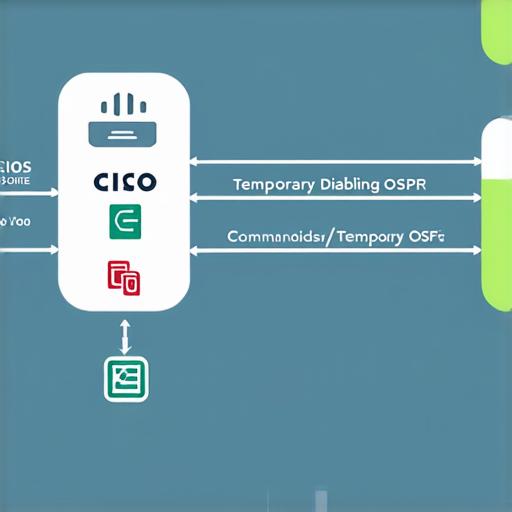As an IOS developer, you may need to temporarily disable the Open Shortest Path First (OSPF) process in order to troubleshoot network issues or perform maintenance tasks.
In this article, we will explore the various Cisco IOS commands that allow for the temporary disabling of OSPF and discuss their advantages and disadvantages.
Why Temporarily Disable OSPF?
OSPF is a popular link-state routing protocol that is commonly used in IP networks to determine the shortest path between routers. While OSPF can be very useful for optimizing network performance, there are times when it may need to be temporarily disabled.
For example:
- During network maintenance tasks such as software updates or hardware replacements, disabling OSPF can prevent unnecessary traffic from being generated and reduce the risk of network instability.
- When troubleshooting connectivity issues, disabling OSPF can help isolate the problem and make it easier to identify the root cause.
- In some cases, disabling OSPF may be required by network policies or regulations, such as in environments where security is a top priority.
How to Temporarily Disable OSPF
There are several Cisco IOS commands that allow for the temporary disabling of OSPF. The most commonly used commands are:
OSPF Network StatementGlobal Configuration CommandRouter Configuration Mode Command
1. OSPF Network Statement
The network statement in global configuration mode is used to enable and disable OSPF on specific networks. To temporarily disable OSPF, you can use the no network command followed by the network address and mask.
Advantages of Using the OSPF Network Statement
- The
networkstatement allows for fine-grained control over which networks are enabled or disabled for OSPF. This makes it easy to disable OSPF on specific networks while leaving others running. - Disabling OSPF using the
networkstatement is a simple and straightforward process that can be easily done in global configuration mode. - The
networkstatement does not require any additional configuration or parameters to be set, making it a convenient option for temporarily disabling OSPF.
Disadvantages of Using the OSPF Network Statement
- Disabling OSPF using the
networkstatement will also disable any other protocols that are configured to use the same network address and mask, such as EIGRP or RIP. This means that you may need to re-enable these protocols separately if you want them to continue running on the disabled network. - The
networkstatement does not provide any information about when OSPF will automatically re-enable, which can make it difficult to plan maintenance tasks or troubleshoot connectivity issues.
2. Global Configuration Command
The router ospf process-id area-id command in global configuration mode is used to enable and disable the OSPF process on a specific router. To temporarily disable OSPF, you can use the no keyword followed by the process ID and area ID.
Advantages of Using the Global Configuration Command
- The
router ospf process-id area-idcommand allows for more granular control over which areas of the network are enabled or disabled for OSPF, making it easier to disable OSPF on specific networks. - Disabling OSPF using the
router ospf process-id area-idcommand will only disable OSPF on the specified router and area, leaving other routers and areas running. - The
router ospf process-id area-idcommand provides information about when OSPF will automatically re-enable, which can make it easier to plan maintenance tasks or troubleshoot connectivity issues.
Disadvantages of Using the Global Configuration Command
- Disabling OSPF using the
router ospf process-id area-idcommand requires additional configuration and parameters to be set, which can make it more complex than using thenetworkstatement. - The
router ospf process-id area-idcommand may not be available on all Cisco devices, depending on the version of IOS being used.
3. Global Configuration Mode Command
The no router ospf process-id command in global configuration mode is used to disable the OSPF process on a specific router. This command can be used to temporarily disable OSPF on a single router, without affecting other routers or areas of the network.
Advantages of Using the Global Configuration Mode Command

- The
no router ospf process-idcommand allows for more granular control over which routers are enabled or disabled for OSPF, making it easier to disable OSPF on specific networks. - Disabling OSPF using the
no router ospf process-idcommand will only disable OSPF on the specified router, leaving other routers and areas running. - The
no router ospf process-idcommand provides information about when OSPF will automatically re-enable, which can make it easier to plan maintenance tasks or troubleshoot connectivity issues.
Disadvantages of Using the Global Configuration Mode Command
- Disabling OSPF using the
no router ospf process-idcommand requires additional configuration and parameters to be set, which can make it more complex than using the other commands. - The
no router ospf process-idcommand may not be available on all Cisco devices, depending on the version of IOS being used.
4. Router Configuration Mode Command
The router ospf process-id area-id command in router configuration mode is used to enable and disable the OSPF process on a specific router. To temporarily disable OSPF, you can use the no keyword followed by the process ID and area ID.
Advantages of Using the Router Configuration Mode Command
- The
router ospf process-id area-idcommand allows for more granular control over which areas of the network are enabled or disabled for OSPF, making it easier to disable OSPF on specific networks. - Disabling OSPF using the
router ospf process-id area-idcommand will only disable OSPF on the specified router and area, leaving other routers and areas running. - The
router ospf process-id area-idcommand provides information about when OSPF will automatically re-enable, which can make it easier to plan maintenance tasks or troubleshoot connectivity issues.
Disadvantages of Using the Router Configuration Mode Command
- Disabling OSPF using the
router ospf process-id area-idcommand requires additional configuration and parameters to be set, which can make it more complex than using the other commands. - The
router ospf process-id area-idcommand may not be available on all Cisco devices, depending on the version of IOS being used.
Summary
Temporarily disabling OSPF on a network can be useful for maintenance tasks or troubleshooting connectivity issues. There are several different commands that can be used to disable OSPF, each with its own advantages and disadvantages. The choice of command will depend on the
